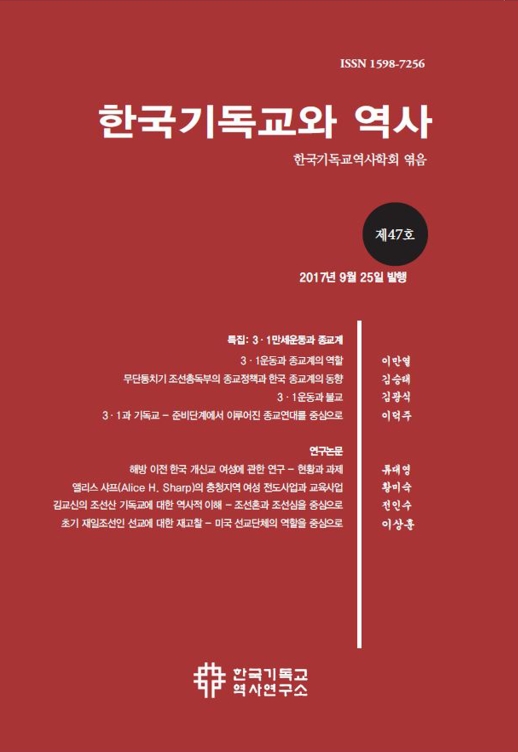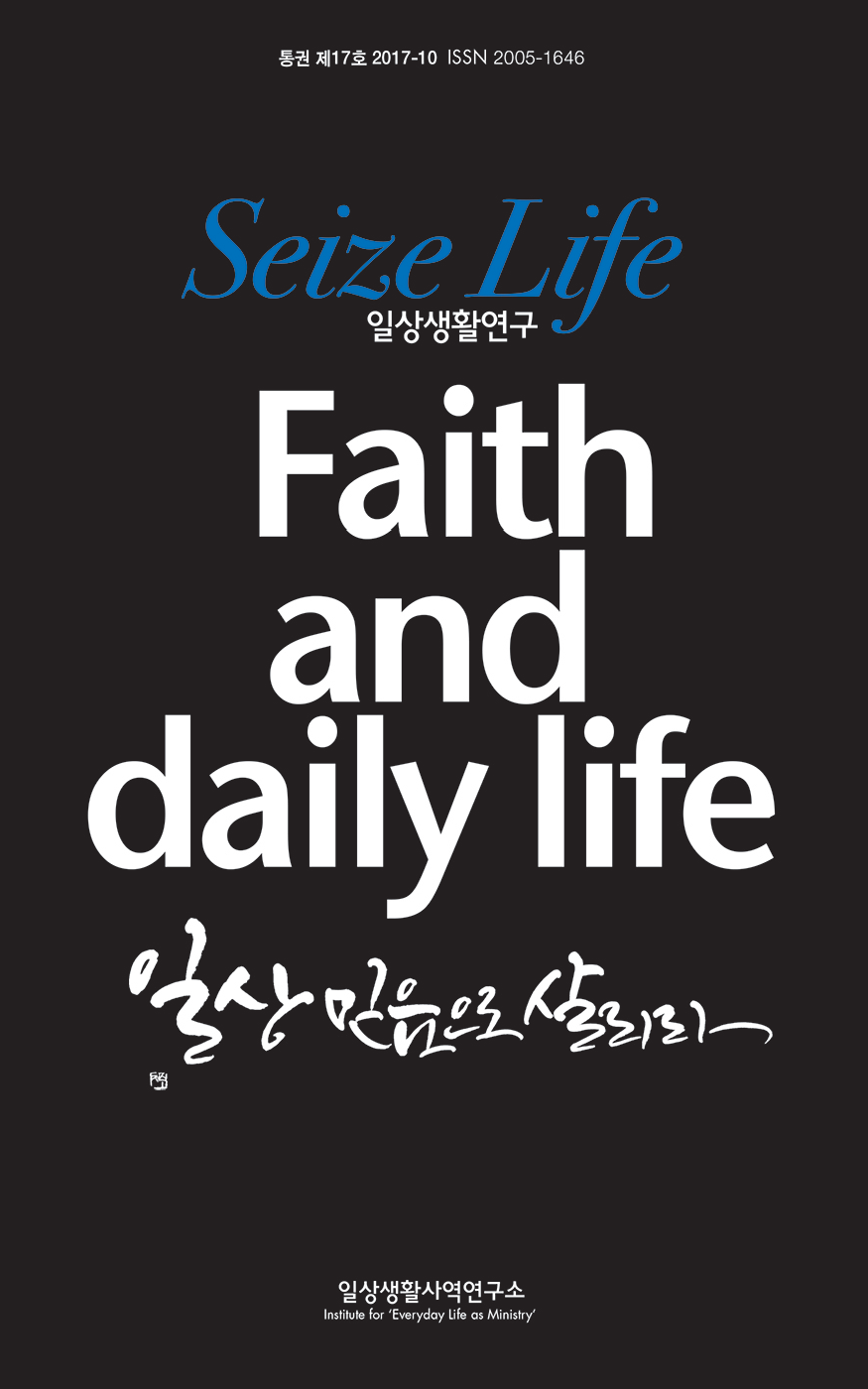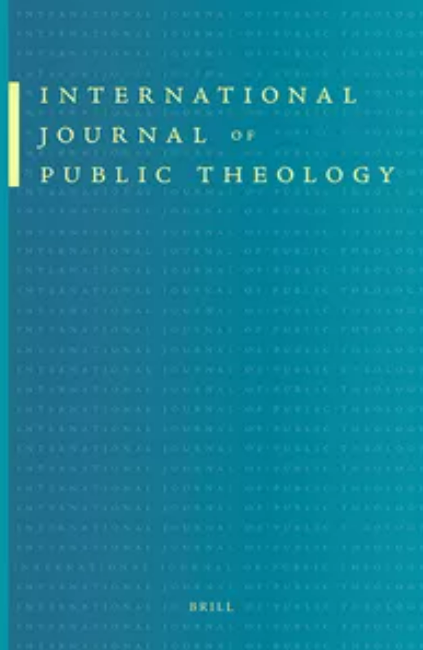1919년 3·1운동이 일어났을 때 한국 기독교(개신교)는 선교역사가 30년이 되지 않은 ‘신흥종교’ 수준이었다. 종교인 비율로 봐도 전체 인구의 1.5% 수준에 머무는 ‘소수종교’였다. 그럼에도 불구하고 3·1운동의 준비, 모의단계로부터 대중 투쟁단계, 그리고 3·1운동 후 임시정부 조직에 이르는 전 과정에서 기독교계가 적극적이고 주도적인 역할을 수행할 수 있었던 세 가지로 설명할 수 있다. 첫째, 한국 기독교는 선교초기부터 강력한 ‘민족주의 종교’로 성격이 형성되었다. 19세기말 근대화시기에 서구 선교사들에 의해 한국에 소개된 기독교 복음은 ‘자유와 평등’의 메시지를 한민족에게 전달하였다. 그리하여 봉건적 사회체제에서 억압당하며 살았던 하층민과 부녀자 계층이 기독교를 통해 자유와 평등의 가치를 체득, 실천하였다. 그 결과 한국 사회는 기독교를 통하여 서구문화와 문명의 유입이 이루어졌고 그와 함께 수직적 질서가 강조되던 봉건사회가 붕괴되면서 수평적 가치가 구현되는 시민사회로 바뀌었다. 이처럼 한말 민족사회의 근대화에 기여한 기독교는 일제 강점기에 접어들어 일제의 식민통치에 저항하며 민족의 자주독립을 위해 투쟁하는 종교로 변모하였다. 그것 역시 일제의 억압통치로부터 민족의 ‘자유와 해방’을 구현하기 위한 투쟁이었다. 그 결과 한국 기독교는 민족문제에 대하여 적극적인 관심을 표명하고 참여하는 민족주의 성향을 띠게 되었다. 둘째, 한국교회는 식민통치 상황에서 민족문제를 논의하고 투쟁하는 ‘민족운동 공간’이 되었다. 선교초기부터 서구 선교사들은 정교분리를 표방하며 기독교인들의 정치 참여나 활동을 금지하는 한편 교회 안에서 이루어지는 종교 활동에 간섭하지 않도록 정치권(총독부)과 타협하였다. 그 결과 일제강점기 교회는 선교사들의 보호 아래 ‘치외법권적 영역’이 되었을 뿐 아니라 총회와 연회, 지방회(노회)를 연결하는 전국 연락망을 갖추었다. 그리하여 경찰력이 미치지 않았던 교회와 기독교 선교기관 안에서 (선교사들의 의도와 달리) 민족주의 교회 지도자들이 모여 민족문제를 논의하고 항일 민족저항운동을 전개할 수 있었다. 3·1운동 때 만세독립운동에 관한 정보와 자료가 지방에 신속하게 전파되어 전국적인 시위운동이 일어날 수 있었던 것도 이와 같은 ‘전국 연락망’을 갖춘 교회와 기독교의 연결 조직이 있어 가능했다. 셋째, 한국 기독교의 초교파 연합운동 경험이 종파를 초월한 ‘전 민족적’ 독립운동을 가능케 하였다. 선교초기 각기 다른 교파와 교단을 배경으로 하여 내한한 선교사들에 의해 ‘교파중심’ 교회 설립과 선교가 추진되었다. 그러다가 1903~07년 일어난 초기 부흥운동의 여파로 교회 일치운동이 일어나 성서번역과 문서출판, 의료와 교육 사역에서 초교파 연합운동이 활발하게 전개되었다. 이러한 연합과 연대 경험을 바탕으로 3·1운동 때 장로교와 감리교 목회자, 평신도 지도자들이 천도교와 불교 등 다른 종파 지도자들과 함께 민족대표로 참여할 수 있었고 서울과 지방에서 교회 지도자들이 다른 종파 지도자, 일반 시민들과 연대해서 독립만세운동을 전개하였다. 한국 기독교는 3·1운동을 통해 교파와 종파를 초월하여 대동단결하는 민족운동 전통을 수립하였다. 이렇듯 선교초기부터 민족주의 성향을 띠었던 한국 기독교는 3·1운동을 거치면서 민족주의 종교로서 그 성격과 역할이 더욱 강화되었다. 그런 배경에서 한국 기독교는 일제 강점기 식민통치 하에서 항일민족운동에 적극 참여할 수 있었다.
When the March 1st Movement took place in 1919, Korean Christianity (Protestantism) was at the level of ‘emerging religion’ with a history of less than 30 years. It was also a ‘minority religion’ that stood at 1.5% of the total population of Korea. Nonetheless, Korean Christians played an active and leading role in the whole process the March 1st Movement, from the preparatory stage of forming of the national representatives who signed on the Declaration of Independence to the organization of the Provisional Government of Korea via mass struggle for independence. There are three points to be clarified historic-theologically in understanding of Christian participation in March 1st Movement. First, Korean Christianity took a strong nationalistic character from the early days of mission history. When Christianity was introduced to Korea by the western missionaries at the late 19th century, it brought modern civilization and culture to Korean society and also conveyed the message of ‘freedom and equality’ to the Korean people under feudal social system. Thus, the lower classes and women who lived under oppression learned and implemented the value of freedom and equality through Christianity. Thus, it can be said that Christianity contributed to the modernization of Korean society with the introduction of western civilization and modern human right ideologies. And Korean Christians, under the Japanese colonial domination from 1910, began to resist against the Japanese colonial rule and fought for the independence of the nation. It was also a struggle for the realization of ‘freedom and liberation’ of Christianity. Korean Christianity became more inclined toward nationalism by participation in the March 1st Movement. Second, the Christianity provided a ‘national movement space’ in which it could be discussed and tackled the national problem under the Japanese colonial domination. From the early days of mission history, Western missionaries, standing by the principle of separating politics and religion, opposed and prohibited political participation of Korean Christians, and also compromised with the political government(Japanese governor general in Korea) to not interfere with religious activities in the church. As a result, Church could get an ‘extraterritorial’ or relative autonomous position under the protection of foreign missionaries, and also, through the organization of the Korean Church, it could establish a network covering the whole country. So the Korean Christian nationalists, unlike the missionaries intention, gathered in the Church that did not reach the hands of Japanese police and discussed the anti-Japanese independence movement. Thus, in the March 1st Movement, the information and materials about the independence movement could be spreaded quickly from Seoul to the provinces, and simultaneous demonstrations could take place across the country by the national network of Christianity. Third, the experience of union and cooperation movement of the Korean Church made it possible to participate in an interdenominational and extra-religious independent movement. From the early days of the mission history, western missionaries and Korean Christians, even with the different and various denominational backgrounds, tried to pursue ecumenical and cooperative alliance in mission field, especially in the lines of Bible translation, publication of Christian books and journal, medical and education works. Based on this union and solidarity experience, the Korean Church leaders, Presbyterian and Methodist, were able to participate as national representatives with other religious leaders such as Chondogyo or Buddhism in the March 1st Movement. and also the Church leaders in Seoul and provinces were able to participate in anti-Japanese demonstrations with other religious and non-Christian civil leaders. In this way, Korean Christianity, which had a tendency toward nationalism from the beginning of the mission, strengthened its character and role as a nationalistic religion through the March 1st Movement. In such a background, Korean Christianity was able to take a positive position in the anti-Japanese nationalistic movement during the Japanese colonial rule.







